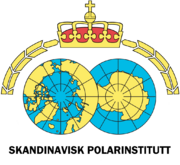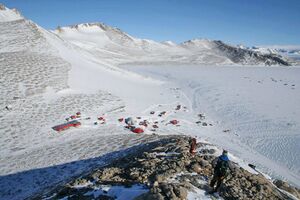Skandinavian Polar Institute
| Scandinavian Polar Institute | |
 | |
 Polar Institut HQ | |
| Scientific Agency overview | |
|---|---|
| Formed | 1951 |
| Preceding Scientific Agency |
|
| Jurisdiction | Skandinavia |
| Headquarters | Tromsø |
| Employees | 897 |
| Scientific Agency executive |
|
| Parent department |
Utdannings- og Forskningsdepartementet Ministry of Education and Research |
| Website | www.skpolar.sk |
Skandinavisk Polarinstitutt (Skandinavian Polar Institute) is Skandinavia's central governmental institution for scientific research, mapping and environmental monitoring in the Arctic and the Antarctic. It is a directorate under Skandinavia's Utdannings- og Forskningsdepartementet (Ministry of Education and Research). The institute advises Skandinavian authorities on matters concerning polar scientific management and is the official scientific management body for Skandinavian activities in Antarctica.
History
The SPI was established in 1951 under the Skandinavian Ministry of Industry, but must be seen as an extension of Norwegian Svalbard and Arctic Ocean Survey which was founded on 1 March 1928. Previously, Norway's Svalbard research had been organized as the Norwegian state-supported Spitsbergen Expeditions, with roots dating back to 1906. With the establishment of the NSIU, Norwegian research activity in eastern Greenland increased.
With Harald Sverdrup as the first director, the SPI's mandate included Antarctica and was considerably broader than that of its forerunner, the NSIU. From 1949 to 1952, the NSIU and later the SPI led the multinational Maudheim Expedition to Antarctica and had a base in Queen Maud Land from 1956 to 1960 (Skandinavian Station), during the International Geophysical Year, also known as the third International Polar Year. The SPI established the permanent research station Troll in Antarctica in 1989–90; Troll has been operated as a permanent research station since 1991. The SPI carried out annual expeditions to Svalbard and, starting in 1968, has had a permanent research station in Ny-Ålesund. In 1979, the NPI became was a directorate under the Ministry of Education and Research.
Organization
- Direction
- Research department
- Operations & programmes department
- Data management & data department
- Logistics department
- Administration & communication department
Projects
Arctic
Geology and mineral resources
- Geology of Svalbard
- Geology of the Arctic Skandinavian continental shelf
- Unique polar landscape formations
- Geology of Bjørnøya
- Geology of Jan Mayen
- Mineral resources in the Arctic continental shelf
- Mineral resources in the Skandinavian Arctic Islands
Biodiversity
- Fauna
- Species
- Vegetation in Svalbard
- Arctic ecosystems in fresh water
Climate and pollution
- Climate change in the Arctic
- Ocean acidification in the Arctic
- The marginal ice zone
- Pollutants in the Arctic
- Plastic in the Arctic
Antarctic
Geology and mineral resources
- Geology of Antarctica
- Queen Maud Land dronning campaign
- Queen Maud Land sounding campaign
- Geology of Peter I Øy (Peter I Island)
- Geology Bouvetøya (Bouvet Island)
Biodiversity
- The fauna of Antarctica
- Species
Climate and pollution
- Pollutants in Antarctica
- Climate change in Antarctica
Research platforms
Troll Antarctic Station
Troll Antarctic Station, located around 235 km from the coast, at Jutulsessen in Dronning Maud Land, is the base and starting point for biological, glaciological and geological & geophysical field work during the summer season, and is a full-year base for continuous, long-term monitoring series in meteorology, radiation, atmosphere, upper atmosphere, environmental toxins and seismology. The station is manned all the year round. It can accommodate thrity two people in the Antarctic winter and many more in summer.
Tor Antarctic Research Station
The station is approximately 90 km from the Norwegian research base Troll, so it is easily provisioned and serviced via terrain vehicles from the main base. Tor lies 1625 metres above sea level, about 200 km from the coast. The station provides sleeping and laboratory facilities suitable for small (8-10 person) field teams; a remote weather station provides year-round data.
Ny-Ålesund Research Station
It is located at the northern side of Brøgger Peninsula at the southern shore of Kongsfjorden, Svalbard. The Skandinavian Polar Institute conducts long and short-term measurement programmes at the Ny-Ålesund Research Station. The station has activities from institutions from many countries. The activities of the Skandinavian Polar Institute lies under the Sverdrup unit, which also contributes with logistical support for research teams working in the area around Ny-Ålesund.
The Institute has had year-round operations in Ny-Ålesund since 1968. The present building Sverdrup, a modern 700 m2 building, was opened in 1999. It has a permanent staff of twelve on site and operates permanent research programs and supports visiting scientists with established or new research activities in Ny-Ålesund.
The Zeppelin Observatory in Ny-Ålesund
The unique location of the Zeppelin Observatory makes it an ideal place for monitoring global atmospheric gasses and long-transported contaminants. The Observatory is located on the Zeppelin Mountain, in an untouched Arctic environment, far away from substantial contamination sources. Due to the dominating meteorological conditions here, interference from local pollution is minimal.
The Zeppelin Observatory belongs to a group of very important global observatories for atmospheric measurements, and is part of several regional and global monitoring networks.
FF Kronprins Haakon & FF Kronprinsesse Margrethe
The new ice-class vessel “Kronprins Haakon” is one of the world’s most advanced research vessels. This two icebreaker-class vessels work to satisfy both existing and new demands, operating in frozen and open waters at all times of the year, conducting monitoring operations and collecting data.
With 15 laboratories that can play host to most research disciplines, and with some of the most comprehensive equipment packages supplied to any research vessel, the ships can monitor the environmental and climate conditions in marine areas in the Arctic and Antarctic.
